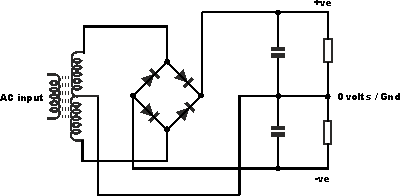Farukh Khan
- Jun 12, 2015
- 160
- Joined
- Jun 12, 2015
- Messages
- 160
Hello,
I have two center tapped transformers with the following specifications on the secondary side >
*12V x 2 or 24V from the full secondary coil. And, 12V on each side of the center tap.
* 3000mA rating.
I am trying to create a simple bridge rectifier solution to output all the power the transformer has to offer, most efficiently possible. Now, for the center tap, I am confused how do I use this transformer to output the maximum DC overall voltage and amps it can deliver. While searching online I came across this schematic and am not really sure how this schematic is working. Is this a good solution to implement for getting the maximum available power from a center tapped transformer?

Please need some suggestions regarding this. And also, in the future I am willing to use these two transformer's DC output either in parallel or series configuration to increase the overall output power whenever necessary and whichever configuration necessary. Thank you.
I have two center tapped transformers with the following specifications on the secondary side >
*12V x 2 or 24V from the full secondary coil. And, 12V on each side of the center tap.
* 3000mA rating.
I am trying to create a simple bridge rectifier solution to output all the power the transformer has to offer, most efficiently possible. Now, for the center tap, I am confused how do I use this transformer to output the maximum DC overall voltage and amps it can deliver. While searching online I came across this schematic and am not really sure how this schematic is working. Is this a good solution to implement for getting the maximum available power from a center tapped transformer?

Please need some suggestions regarding this. And also, in the future I am willing to use these two transformer's DC output either in parallel or series configuration to increase the overall output power whenever necessary and whichever configuration necessary. Thank you.
